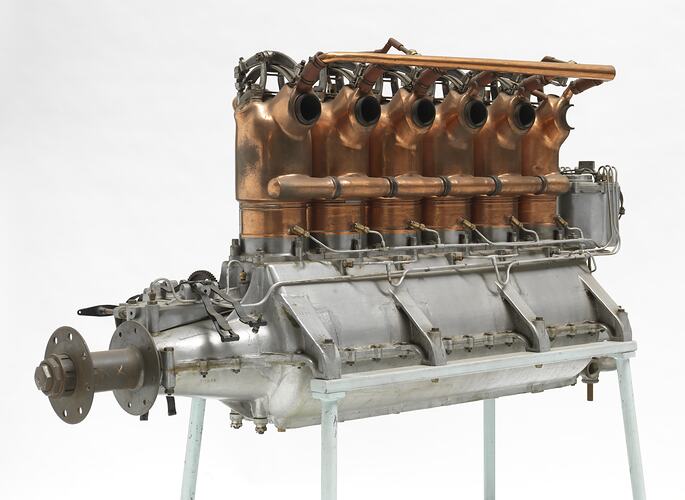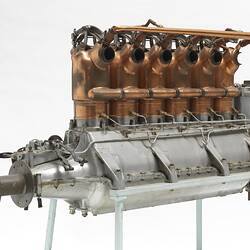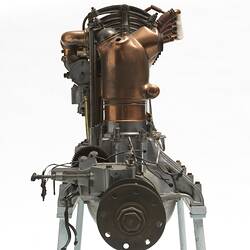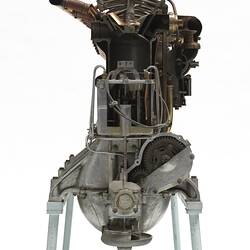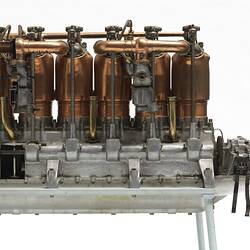Summary
The Austro Daimler 6 was one of the first successful in-line, water-cooled aero engines developed in Europe. The design was used by combatant nations on opposing sides during World War I. In 1912, the Austro Daimler Company allowed Arrol-Johnstone Ltd of Dumfries, Scotland, an automobile maker associated with William Beardmore & Co. of Glasgow, to produce their 120 horsepower six-cylinder engine under licence. The design was later modified by fitting larger cylinders to produce a 160 horsepower model.
This engine was acquired from the Science Museum in London. It is a 120 horsepower British-built model sold through The Beardmore Aero Engine Ltd, being of the type fitted to the de Havilland designed Airco DH.1 and F.E. series pusher biplanes produced under the direction of the Royal Aircraft Factory. It is marked 'G.W. 1022', 'W.D. 1258' and '188'.
The engine was subsequently sectioned by an external contractor for the Air Transport Display in McArthur Hall that opened in March 1970 as part of the Melbourne Science Museum's centenary celebrations.
Unlike the more common European-built Austro Daimler 6 WWI aero engines with a single overhead cam shaft, the Beardmore version has a lower cam shaft located on the left-hand side of the cylinders within the crankcase, using an arrangement more popular in early automotive engines. A single long tappet-rod running up the left-hand side of each cylinder operates both the inlet and exhaust values through a single overhead bell-crank rocker, with a laminated double-ended leaf spring assisting valve closure. The cam shaft is driven by a spur gear train enclosed in the rear of the crankcase, together with bevel gears that drive the oil and water pumps as well as the magnetos. It is fitted with two carburettors and two magnetos. The crankcase is fabricated from an aluminium alloy casting, split horizontally along the centreline of the crankshaft. The individual cylinders with their integral heads are machined from separate iron castings with each independently bolted to the crankcase. A polished copper water jacket surrounds the top half of each cylinder and the pistons are made of mild steel with a slightly concave head.
Physical Description
General Specifications: Type: 6-cylinder, inline, upright piston engine Bore: 5.12 in (130 mm) Stroke: 6.89 in (175 mm) Displacement: 851 cu in (13.145 L) Length: 57 in (1,148 mm) Width: 19.9 in (505 mm) Height: 31.9 in (810 mm) Dry Weight: 545 lb (247 kg) Valve Type: Overhead poppets Fuel Type: Petrol Cooling: Water-cooled Reduction Gear: Direct drive, right-hand tractor Power Output: 154 hp (115 kW) at 1,400 rpm (maximum power) Specific Power: 0.18 hp/cu in (8.74 kw/L) Compression Ratio: 4.85:1 Power-to-Weight Ratio: 0.28 hp/lb (0.46 kW/kg)
More Information
-
Collecting Areas
-
Acquisition Information
Loan & Subsequent Donation from Science Museum (London), 14 Nov 1929
-
Designer
-
Manufacturer
William Beardmore & Co. Ltd, Glasgow, Scotland, Great Britain, circa 1914
-
Distributor
The Beardmore Aero Engine Ltd, 112 Great Portland Street, London, England, Great Britain, circa 1914
-
Brand Names
-
Classification
Air transport, Aero engines, Reciprocating propeller engines
-
Category
-
Discipline
-
Type of item
-
References
Specifications from 'Beardmore 120 hp', Wikipedia, [Link 1] viewed 10/11/2014.
-
Keywords
Aero Engines, Internal Combustion Engines, World War I, 1914-1918
